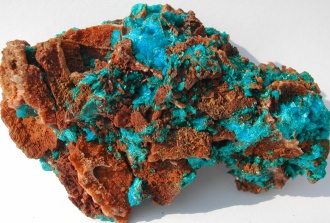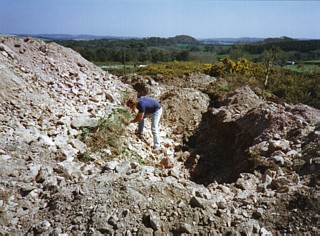|
|
|||||||||
|
|
 |
|
Liroconite has been reported from several locations around the world, but it is only in Cornwall in the UK that it has occurred in large well-formed crystals Cornwall Wheal Gorland, Wheal Muttrell and Wheal Unity, Gwennap, Cornwall Fine crystal clusters were found in these famous Cornish mines in the latter part of the 18th century and the early part of the 19th century. This includes the largest crystal ever found which is 3.5cm long, and crystals to 2 cm were not unusual. These three mines are very close together, and all worked the same series of lodes. Wheal Muttrell later became part of Wheal Gorland. "We pass through Wheal Gorland once without peer, for colours the rarest of very rich ore, and beautiful minerals valued yet more" - from the History of Gwennap by W.Frances (1845). The oxidised zone of the Muttrell Lode was the richest source. This was first worked in the 1790's. Wheal Gorland was abandoned before 1860, but re-opened briefly to work the upper levels until 1909. This yielded only a little tin and some wolframite. It appears no Liroconite was found in this later period of working. After this Liroconite could still be found on the old Wheal Gorland dumps. This was well-known to many enthusiastic collectors and some reasonable specimens were recovered. Tragically these dumps were carted away for processing for tin in the 1970's. Fortunately this is not quite the end of the story however. In the late 1970's a group of mining enthusiasts led by Dave Smith attempted to gain entry to the old Wheal Gorland workings, in particular the Muttrell Lode. Since none of the shafts of the Muttrell Lode was open to surface, they decided to explore a shaft that was on Davey's Lode. According to the plans there was a crosscut leading from Davey's Lode to the Muttrell Lode. A huge effort and program of work commenced. Due to the dedication of Dave Smith and friends they have succeeded in getting down to the old levels. The story of this is provided in the book 'Project Gorland - The Re-digging' by Dave Smith, 1997. Since this was written, Dave himself has tragically died, but the work still continues. While they have found a number of secondary copper minerals such as Chalcopyllite, Connellite, Langite and Cuprite, they have not found Liroconite. They have also so far failed to break through into the Muttrell Lode. It would be wonderful if they are eventually successful. An old account of Wheal Gorland written by William Phillips in 1811 provides a rare and fascinating insight into the mineralogy of this old mine and the occurrence of its minerals. The main subject of this account was Cuprite and Pharmacosiderite, but it provides valuable and almost unique information on where the Copper Arsenates such as Liroconite were found. |
|
|
||||||||||||||||||||||||||||
|
Ting Tang mine, Gwennap, Cornwall A number of old Liroconite specimens in museums are reported as coming from the Ting Tang mine in Cornwall. This mine is also within the parish of Gwennap, just over a mile from Wheal Gorland, Wheal Muttrell and Wheal Unity. J.H.Collins however makes no mention of this location, and several mineralogists have concluded that specimens marked as having been found at Ting Tang are mislocated and must have been collected from Wheal Gorland. A photograph of such a specimen of Liroconite is shown below. Note the comments on its museum label. |
 |
|
|
Liroconite - Ting Tang mine, Gwennap, Cornwall, UK Specimen in the Royal Cornwall Museum, Truro, UK, almost certainly correctly labelled as coming from the old Ting Tang mine when it was working (see discussion below). |
|
|
The old Ting Tang mine dumps were reputed as being a source of secondary copper arsenates such as Olivenite, but the site was difficult to access and largely grassed over. Then in 1997 arrangements were made with the land owner for a systematic dig to take place in the dumps adjacent to what was believed to be Morcom's Shaft. The author was one of those lucky enough to take part. The subsequent explorations and dig revealed a large suite of well crystallised supergene specimens, including a few excellent Liroconite specimens with crystals to 4mm and other secondary copper arsenates. The photograph opposite shows one of the Liroconite specimens recovered. Unfortunately the number of Liroconite's was all too few, there being less than ten fine ones. Details of the finds can be found in a paper written by the author and Ian Bruce (Number 19 of the UK Journal of Mines and Minerals 1998). This would appear to prove the correctness of the museum labels that had attributed Ting Tang as the locality for a significant number of old Liroconite specimens. Mineralogists wishing to access the site must contact the landowner, Brian Coynes. |
|
|
||||||||||||||||||||||||||||||||
|
Great Hewas United mine, St Austell, Cornwall J.H.Collins stated that Great Hewas was a source of Liroconite, but not in such fine specimens as in Wheal Gorland and other mines in the Gwennap district. Great Hewas operated under the United name from 1813 until 1822 and produced mainly tin, although some copper was also found. In 1846 it re-started under the name Great Hewas Consols, and now incorporated some other setts including Wheal Husband. Funds quickly became exhausted however, and after a few more years of lying idle it once again regained (1854) the name of Great Hewas United. This last company continued in operation until 1860 and a subsequent attempt to re-work the mine failed. Wheal Husband has been the source of some fine Malachite specimens. Perhaps it was from here that Liroconite occurred. Gunnislake mine, Gunnislake, Cornwall Collins also reports that the Gunnislake mine was a source of Liroconite specimens, but that these were not as fine as those from Gwennap. Huel Providence, Lelant, Cornwall Liroconite is also said to have occurred from the Huel Providence mine, according to J.H.Collins. |
|
Devon Devon is a county that adjoins the county of Cornwall, and parts of it have a very similar Geology. It should therefore come as no surprise that Liroconite is rumoured to have been found in Devon too. However, the exact location is unknown. Bedford United mine has produced other copper arsenate minerals such as Clinoclase and Olivenite. Interestingly J.H.Collins reports Liroconite from the Gunnislake mine (see J.H.Collins), but not in such fine specimens as Wheal Gorland. Gunnislake is is on the border between Cornwall and Devon on the edge of the river Tamar, just on the Cornish side. |
|
Copyright (C) 2003-2008 David Aubrey-Jones. All rights reserved. No part of this Web site and its contents may be reproduced in any form without the written permission of the author. |
|
[Liroconite] [Rarity] [Discovery] [Habit & Form] [Descriptions] [Locations] [Cornish Minerals] [Links] [About us] |



